Brown marmorated stink bug
| Brown marmorated stink bug | |
|---|---|
| Adult | |
| Scientific classification | |
| Kingdom: | Animalia |
| Clade: | Euarthropoda |
| Class: | Insecta |
| Order: | Hemiptera |
| Family: | Pentatomidae |
| Genus: | Halyomorpha |
| Species: | H. halys |
| Binomial name | |
| Halyomorpha halys | |
The brown marmorated stink bug (Halyomorpha halys) is an insect in the family Pentatomidae that is native to China, Japan, the Korean peninsula, and Taiwan.[2] It was accidentally introduced into the United States, with the first specimen being collected in September 1998.[3] The brown marmorated stink bug is an agricultural pest[4] and by 2010–11 had become a season-long pest in U.S. orchards.[5] It is now established in many parts of North America and has recently established itself in Europe and South America.[6]
Description
The adults are approximately 1.7 cm (0.67 in) long and about as wide, forming the shield shape characteristic of other stink bugs. They are various shades of brown on both the top and undersides, with gray, off-white, black, copper, and bluish markings. The term "marmorated" means variegated or veined like marble.[7] Markings unique to this species include alternating light bands on the antennae and alternating dark bands on the thin outer edge of the abdomen. The legs are brown with faint white mottling or banding. The stink glands are located on the underside of the thorax, between the first and second pair of legs, and on the dorsal surface of the abdomen.[8]
Behavior
The brown marmorated stink bug is a sucking insect (like all Hemiptera or "true bugs") that uses its proboscis to pierce the host plant to feed. This feeding results, in part, in the formation of dimpled or necrotic areas on the outer surface of fruits, leaf stippling, seed loss, and possible transmission of plant pathogens. It is an agricultural pest that can cause widespread damage to fruit and vegetable crops. In Japan, it is a pest to soybean and fruit crops. In the U.S., the brown marmorated stink bug feeds, beginning in late May or early June, on a wide range of fruits, vegetables, and other host plants including peaches, apples, green beans, soybeans, cherries, raspberries, and pears.
The brown marmorated stink bug is more likely to invade homes in the fall than others in the family.[9] The bug survives the winter as an adult by entering houses and structures when autumn evenings become colder, often in the thousands. In one home, more than 26,000 stinkbugs were found overwintering.[10] Adults can live from several months to a year.[11][12] They enter under siding, into soffits, around window and door frames, chimneys, or any space which has openings big enough to fit through. Once inside the house, they go into a state of hibernation. They wait for winter to pass, but often the warmth inside the house causes them to become active, and they may fly clumsily around light fixtures. Two important vectors of this pest are the landscape ornamentals tree of heaven and princess tree.[13]
The odor from the stink bug is due to trans-2-decenal and trans-2-octenal.[14] The smell has been characterized as a "pungent odor that smells like coriander."[5] The stink bug's ability to emit an odor through holes in its abdomen is a defense mechanism meant to prevent it from being eaten by birds and lizards. However, simply handling the bug, injuring it, or attempting to move it can trigger it to release the odor.
During courtship, the male emits pheromones and vibrational signals to communicate with a female, which replies with her own vibrational signals, as in all stink bugs. The insects use the signals to recognize and locate each other. Vibrational signals of this species are noted for their low frequency, and one male signal type is much longer than any other previously described signals in stink bugs, although the significance of this is not yet clear.[15]
In North America
The brown marmorated stink bug was accidentally introduced into the United States from China or Japan. It is believed to have hitched a ride as a stowaway in packing crates or on various types of machinery. The first documented specimen was collected in Allentown, Pennsylvania, in September, 1998.[4][16] Several Muhlenberg College students were reported to have seen these bugs as early as August of that same year.[9][17] Between 2001 and 2010, 54 sightings were reported of these bugs at shipping ports in the United States.[18] However, stink bugs are not listed as reportable, meaning that they do not need to be reported and no action is required to remove the insect. This allowed the insect to enter the United States relatively easily, as they are able to survive long periods of time in hot or cold conditions.
Other reports have the brown marmorated stink bug documented as early as 2000 in New Jersey from a black light trap run by the Rutgers Cooperative Extension Vegetable Integrated Pest Management program in Milford, New Jersey. [19]
In 2002, in New Jersey, it was found on plant material in Stewartsville, and was collected from black light traps in Phillipsburg and Little York. It was quickly documented and established in many counties in Pennsylvania, New Jersey, Delaware, Connecticut, and New York on the eastern coast of the United States.
By 2009, this agricultural pest had reached Maryland, West Virginia, Virginia, Tennessee, North Carolina, Kentucky, Ohio, Illinois, and Oregon.[20] In 2010 this pest was found in additional states including Indiana,[21] Michigan,[22] Minnesota,[23] and other states.[24]
As of November 2011, it had spread to 34 U.S. states[5] and by 2012 to 40, and showed an increase of 60% in total numbers over 2011.[25]
Their populations have also spread to southern Ontario and Quebec, Canada.[26][27]
Population increase
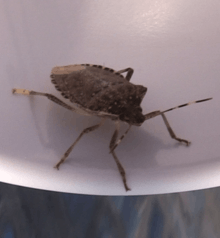
As of 2010, 17 states had been categorized as having established populations, and several other states along the eastern half of the United States were reported as having more than normal numbers of stink bugs.[28][29] Stink bug populations rise because the climate in the United States is ideal for their reproduction. In optimal conditions, an adult stink bug can develop within 35 to 45 days after hatching.[18] Female stink bugs are capable of laying four hundred eggs in their lifetime.[30] The bug is also capable of producing at least one successful generation per year in all areas of the United States, no matter the climate. In warmer climates, multiple generations can occur annually, which can range from two generations in states such as Virginia to six generations in states such as California, Arizona, Florida, Louisiana, Georgia, and Texas.[18][31][32]
The addition of two more generations allowed the population to explode, leading to the establishment of several other populations in neighboring states. Currently, no environmental limiting factors are apparently slowing their distribution across North America. They also are extremely mobile insects, capable of moving from host to host without causing disruption in their reproductive processes. Currently, populations are estimated to continue to grow and spread to other states and provinces, especially during unusual periods of warm weather.
Agricultural effects

The brown marmorated stink bug is a serious agricultural pest that has been readily causing damage to crops across the Eastern United States. They feed on a wide array of plants including apples, apricots, Asian pears, cherries, corn, grapes, lima beans, peaches, peppers, tomatoes, and soybeans.[33] This makes them extremely versatile, as they do not require a specific plant on which to feed. To obtain their food, stink bugs use their stylets to pierce the plant tissue to extract the plant fluids.[34] In doing so, the plant loses necessary fluids, which can lead to deformation of seeds, destruction of seeds, destruction of fruiting structures, delayed plant maturation, and increased vulnerability to harmful pathogens.[34] While harvesting the plant's juices, the stink bug injects saliva into the plant, creating a dimpling of the fruit's surface and rotting of the material underneath.
The most common signs of stink bug damage are pitting and scarring of the fruit, leaf destruction, and a mealy texture to the harvested fruits and vegetables. In most case, the signs of stink bug damage makes the plant unsuitable for sale in the market, as the insides are usually rotten. In field crops such as corn and soybeans, the damage may not be as evident as the damage seen in fruit plants. When stink bugs feed on corn, they go through the husk before eating the kernels, hiding the damage until the husks are removed during harvesting. The same damage is seen in soybeans, as the stink bug goes through the seed pods to acquire the juices of the seeds. One visual cue of stink-bug damage to soybean crops is the "stay green" effect, where damaged soybean plants stay green late into season, while other plants in the field die off normally. One can usually tell that a field of crops is infected because stink bugs are known for the "edge effect", in which they tend to infest crops 30-40 ft from the edge of the field. Farmers who suspect having stink bugs in their crops should contact their respective departments of agriculture for information on how to manage the infestation and possible ways to prevent future incidences.
Control
Control of stink bugs is a priority of the U.S. Department of Agriculture, which has developed an artificial pheromone which can be used to bait traps. Because the bugs insert their probosces below the surface of fruit and then feed, some insecticides are ineffective; in addition, the bugs are mobile, and a new population may fly in after the resident population has been killed, making permanent removal nearly impossible. In the case of soybean infestations, spraying only the perimeter of a field may be the most effective method of preventing stinkbugs from damaging the crops. However, even this method is limited, as new populations move back into the area, or the existing population simply moves to unaffected areas. Evidence also shows that stink bugs are developing a resistance to pyrethroid insecticides, a common chemical used to combat infestations.[18] Other insecticides currently in field trials that are showing promising results are oxamyl (96% mortality rate) and moribund (67% mortality rate).[18] Many other commonly used insecticides are merely used to keep the insects out of fields, rather than actually killing them. The most successful method of protecting apples found thus far is the use of kaolin clay.[18] As of 2012, native predators such as wasps and birds were showing increased signs of feeding on the bugs as they adapt to the new food source.[25] Managing this pest species is challenging because few effective pesticides are labeled for use against them.
Similarity in appearance to native species
Easily confused with Brochymena and Euschistus, the best identification for adults is the white band on the antennae. It is similar in appearance to other native species of shield bug, including Acrosternum, Euschistus, and Podisus, except that several of the abdominal segments protrude from beneath the wings and are alternatively banded with black and white (visible along the edge of the bug even when wings are folded) and a white stripe or band on the next to last (fourth) antennal segment.[35] The adult rice stink bug (Oebalus pugnax) is distinguishable from the brown marmorated stink bug by noting the straw color, the smaller size, and the elongated shape of the rice stink bug.[36]
Predators
In China, Trissolcus japonicus,[37] a parasitoid wasp species in the family Scelionidae, is a primary predator.[38] This species is not currently present in the U.S., but is undergoing study for possible introduction.[5] The major problem with this idea is the possibility that japonicus will also become an invasive species with no native predators. Before introducing the Chinese wasp, scientists are trying to find natural predators of the stink bug already present in the United States. To do so they have studied other species of parasitoid wasps native to the United States. They found that several other species of the parasitoid wasps attacked stink bug eggs in Virginia soybean fields.[39] Researchers have also experimented with different spider species as well as the Wheel bug. Several spider species attacked both the eggs and adult stink bugs. Pill bugs eat stinkbug eggs.[40] The wheel bug, however, was the most voracious predator and attacked the eggs and adults more consistently.[41]
Lifecycle
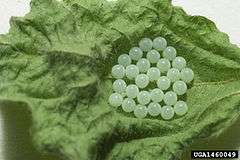 Eggs on leaf
Eggs on leaf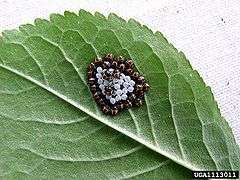 Newly hatched eggs
Newly hatched eggs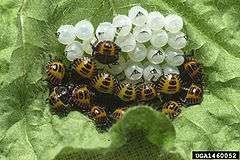 Newly hatched eggs
Newly hatched eggs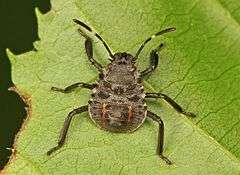 Nymph
Nymph- Fifth-instar nymph
- Last-instar nymph
- Adult
 Halyomorpha halys
Halyomorpha halys
See also
- Stink bug
- Acrosternum hilare, the green stink bug
- Megacopta cribraria, the kudzu bug
- Nezara viridula, the southern green stink bug
- Oebalus pugnax, the rice stink bug
References
- ↑ Wermelinger, Beat; Denise Wyniger; Beat Forster. 2008. First records of an invasive bug in Europe: Halyomorpha halys Stål (Heteroptera: Pentatomidae), a new pest on woody ornamentals and fruit trees? Mitteilungen der Schweizerischen Entomologischen Gesellschaft: Bulletin de la Société Entomologique Suisse 81: 1–8.
- ↑ "Brown Marmorated Stink Bug". Pennsylvania State University. Retrieved May 25, 2011.
- ↑ Jacobs, Steve (September 2010). Brown Marmorated Stink Bug — Entomology — Penn State University:. State College, PA: Penn State University College of Agricultural Sciences. Retrieved October 21, 2010.
- 1 2 "Move Over, Bedbugs: Stink Bugs Have Landed". The New York Times. September 26, 2010. Retrieved September 28, 2010.
Government and university researchers say they need more time to study the bug, which has been in the United States since about 1998. Native to Asia, it was first found in Allentown, Pa., and has no natural enemies here.
- 1 2 3 4 "Stink Bug Invasion: Is a Wasp the Solution to Save Valued Crops?". PBS NewsHour. May 24, 2011. Retrieved May 25, 2011.
- ↑ https://www.researchgate.net/publication/316277383_The_brown_marmorated_stink_bug_Halyomorpha_halys_Stal_1855_Heteroptera_Pentatomidae_in_Chile
- ↑ "marmorate". Oxford English Dictionary (3rd ed.). Oxford University Press. 2000. (Subscription or UK public library membership required.)
- ↑ Jacobs, Steven B. (May 2009). "Entomological Notes: Brown Marmorated Stink Bug" (PDF). Pennsylvania State University Department of Agriculture. Archived from the original (PDF) on October 7, 2011. Retrieved July 1, 2011.
- 1 2 Gyeltshen J; Bernon G; Hodges A. (July 2010). "Brown Marmorated Stink Bug, Halyomorpha halys Stål (Insecta: Hemiptera: Pentatomidae)". University of Florida, IFAS. Retrieved October 25, 2008.
- ↑ Inkley DB, 2012. Characteristics of home invasion by the brown marmorated stink bug (Hemiptera: Pentatomidae). Journal of Entomological Science, 47(2):125–130.
- ↑ Meacham, Jennifer (October 5, 2010). "Asian stink bugs invade Oregon". KATU News. Archived from the original on October 8, 2010. Retrieved April 27, 2011.
- ↑ Marchiando, Collin. "Monitoring for the Brown Marmorated Stink Bug: Frequently Asked Questions". Rutgers University, New Jersey Agricultural Experiment Station. Retrieved April 27, 2011.
- ↑ Wallner AM, Hamilton GC, Nielsen AL, Hahn N, Green EJ, et al. (2014) "Landscape Factors Facilitating the Invasive Dynamics and Distribution of the Brown Marmorated Stink Bug, Halyomorphahalys (Hemiptera: Pentatomidae), after Arrival in the United States" PLoS ONE 9(5): e95691. doi:10.1371/journal.pone.0095691
- ↑ Henderson, Will; Khalilian, Ahmad; Han, Young (July 9–12, 2006). Detecting Stink Bugs/Damage in Cotton Utilizing a Portable Electronic Nose (PDF). Oregon Convention Center; Portland, Oregon: Clemson University. Retrieved March 24, 2010.
- ↑ Polajnar, Jernej; et al. (2016). "Vibrational communication of the brown marmorated stink bug (Halyomorpha halys)". Physiological entomology. doi:10.1111/phen.12150.
- ↑ "Penn State University extension site on the insect". ento.psu.edu. Retrieved September 23, 2010.
- ↑ Invasive.org; Lance, David R. "brown marmorated stink bug". Pennsylvania Department of Conservation and Natural Resources Forestry Archive; Gary Bernon. Invasive.org is a joint project of The Bugwood Network, USDA Forest Service and USDA APHIS PPQ. Retrieved October 25, 2008.
- 1 2 3 4 5 6 ARS. 2010b. Brown Marmorated Stink Bug: Research Updates. USDA-ARS, Kearneysville, WV. 6 pp.
- ↑ "Monitoring for the Brown Marmorated Stink Bug". Rutgers, The State University of New Jersey.
- ↑ LaBonte, James (November 2, 2009). "Brown Marmorated Stink Bug". ODA Plant Division, Insect Pest Prevention and Management; Report. Oregon Department of Agriculture. Retrieved March 26, 2010.
- ↑ "Brown Marmorated Stink Bug: Potentially Serious Pest Found in Indiana". Purdue University. Retrieved May 25, 2011.
- ↑ "State Ag. Department Confirms Brown Marmorated Stink Bug in Michigan". State of Michigan. February 1, 2011. Archived from the original on April 8, 2011. Retrieved May 25, 2011.
- ↑ "Brown Marmorated Stink Bug". Minnesota Department of Agriculture. Retrieved May 25, 2011.
- ↑ "Pest Tracker". Purdue University. Archived from the original on July 20, 2011. Retrieved May 25, 2011.
- 1 2 Darryl Fears (May 26, 2013). "Scientists wage war on pervasive stink bugs". The Washington Post. Retrieved May 27, 2013.
- ↑ "Brown Marmorated Stink Bug". www.omafra.gov.on.ca. Retrieved 2018-09-18.
- ↑ "Insecte nuisible ou ravageur : punaise marbrée (Halyomorpha halys) | Banque d'information 311". www1.ville.montreal.qc.ca (in French). Retrieved 2018-09-18.
- ↑ "On the Trail of the Stink Bug". Penn State University College of Agricultural Sciences. Archived from the original on October 9, 2010.
- ↑ "Qualitative analysis of the pest risk potential of the brown marmorated stink bug (BMSB), Halyomorpha halys (Stål), in the United States" (PDF). Center for Plant Health Science and Technology.
- ↑ "brown marmorated stink bug - Halyomorpha halys". entnemdept.ufl.edu. Retrieved December 8, 2015.
- ↑ Day, Eric (February 24, 2011). "Brown marmorated stink bug" (PDF). Virginia Tech. Retrieved September 23, 2011.
- ↑ Sutphin, Michael (July 25, 2011). "Virginia's tree fruit industry has new insecticide to fight stink bugs". Virginia Tech News. Virginia Tech University. Retrieved September 22, 2011.
- ↑ US EPA, OCSPP, OPP, FEAD. "Brown Marmorated Stink Bug". www.epa.gov. Retrieved December 8, 2015.
- 1 2 McPherson, J. E., and R. M. McPherson. 2000. Stink Bugs of Economic Importance in America North of Mexico, Boca Raton, FL. 253 pp.
- ↑ Bessin, Ric. "Brown Marmorated Stink Bug Look-A-Likes in Kentucky" (PDF). Archived from the original (PDF) on July 19, 2011. Retrieved May 25, 2011.
- ↑ "Rice Stink Bug (Oebalus pugnax)". Louisiana State University AgCenter. Retrieved April 8, 2012.
- ↑ Talamas EJ, Buffington M, Hoelmer K (2013) New synonymy of Trissolcus halyomorphae Yang. Journal of Hymenoptera Research 33: 113–117. doi: 10.3897/JHR.33.5627
- ↑ Pfeiffer, Douglas G. (March 30, 2009). "Brown Marmorated Stink Bug". Fact Sheet. Virginia Tech Department of Entomology. Retrieved February 24, 2011.
- ↑ Roberson, Roy (November 20, 2009). "Natural predators tested for stink bug control". News article. southeast Farm Press. Retrieved March 30, 2009.
- ↑ Bailey, Pat (March 15, 1999). "Humble Roly-Poly Bug Thwarts Stink Bugs in Farms, Gardens". UC Davis News Service. Archived from the original on December 7, 2011.
- ↑ http://www.stopbmsb.org/stopBMSB/assets/File/Research/BMSB-SAP-Dec-2013/Native-Natural-Enemies-Shrewsbury.pdf
Further reading
- Rice, Kevin B.; Bergh, Chris J.; Bergmann, Erik J.; Biddinger, Dave J.; et al. (2014). "Biology, ecology, and management of brown marmorated stink bug (Hemiptera: Pentatomidae)". Journal of Integrated Pest Management. 5 (3): A1–A13. doi:10.1603/IPM14002.
- Khrimian, Ashot; Shearer, Peter W.; Zhang, Aijun; Hamilton, George C.; Aldrich, Jeffrey R. (2008). "Field Trapping of the Invasive Brown Marmorated Stink Bug, Halyomorpha halys, with Geometric Isomers of Methyl 2,4,6-Decatrienoate". Journal of Agricultural and Food Chemistry. 56 (1): 197–203. doi:10.1021/jf072087e. PMID 18069789.
- Funayama, Ken (2004). "Importance of apple fruits as food for the brown-marmorated stink bug, Halyomorpha halys (Stal) (Heteroptera: Pentatomidae)". Applied Entomology and Zoology. 39 (4): 617. doi:10.1303/aez.2004.617.
- Nielsen, Anne L.; Hamilton, George C. (2009). "Life History of the Invasive Species Halyomorpha halys (Hemiptera: Pentatomidae) in Northeastern United States". Annals of the Entomological Society of America. 102 (4): 608. doi:10.1603/008.102.0405.
- Aldrich, J. R.; Khrimian, A.; Chen, X.; Camp, M. J. (2009). "Semiochemically Based Monitoring of the Invasion of the Brown Marmorated Stink Bug and Unexpected Attraction of the Native Green Stink Bug (Heteroptera: Pentatomidae) in Maryland". Florida Entomologist. 92 (3): 483. doi:10.1653/024.092.0310.
- Toyama, Masatoshi; Ihara, Fumio; Yaginuma, Katsuhiko (2006). "Formation of aggregations in adults of the brown marmorated stink bug, Halyomorpha halys (Stål) (Heteroptera: Pentatomidae): The role of antennae in short-range locations". Applied Entomology and Zoology. 41 (2): 309. doi:10.1303/aez.2006.309.
- Nielsen, Anne L.; Shearer, Peter W.; Hamilton, George C. (2008). "Toxicity of Insecticides to Halyomorpha halys (Hemiptera: Pentatomidae) Using Glass-Vial Bioassays". Journal of Economic Entomology. 101 (4): 1439–42. doi:10.1603/0022-0493(2008)101[1439:TOITHH]2.0.CO;2. PMID 18767758.
- Lee, Wonhoon; Kang, Joongnam; Jung, Chansik; Hoelmer, Kim; Lee, Si Hyeock; Lee, Seunghwan (2009). "Complete mitochondrial genome of brown marmorated stink bug Halyomorpha halys (Hemiptera: Pentatomidae), and phylogenetic relationships of hemipteran suborders". Molecules and Cells. 28 (3): 155–65. doi:10.1007/s10059-009-0125-9. PMID 19756390.
- Yang, Zhong-Qi; Yao, Yan-Xia; Qiu, Lan-Fen; Li, Zhong-Xin (2009). "A New Species of Trissolcus (Hymenoptera: Scelionidae) Parasitizing Eggs of Halyomorpha halys (Heteroptera: Pentatomidae) in China with Comments on Its Biology". Annals of the Entomological Society of America. 102: 39. doi:10.1603/008.102.0104.
External links
| Wikimedia Commons has media related to Halyomorpha halys. |
- Wikibooks: Halyomorpha halys
- Stink bug fact sheet (Penn State Fact Sheet on the brown marmorated stink bug)
- brown marmorated stink bug on the UF/IFAS Featured Creatures Web site
- Brown marmorated stink bug in Oregon
- brown marmorated stink bug at Invasive.org (a joint project of The Bugwood Network, USDA Forest Service and USDA APHIS PPQ)
- Species Profile- Brown Marmorated Stink Bug (Halyomorpha halys), National Invasive Species Information Center, United States National Agricultural Library. (lists general information and resources for brown marmorated stink bug)
- Brown marmorated stink bug: protection and response (information and fact sheet from the New Zealand Ministry for Primary Industries)